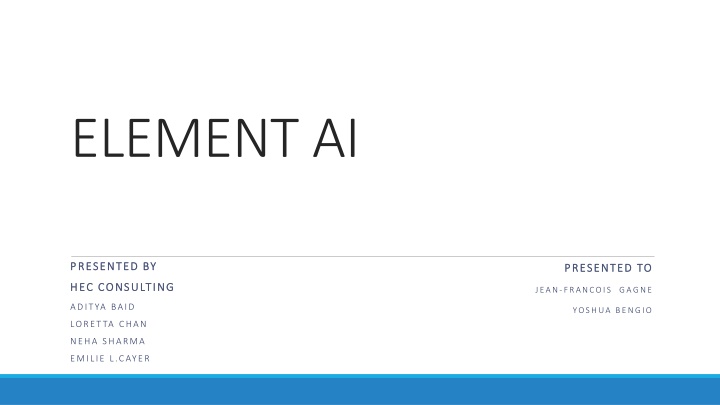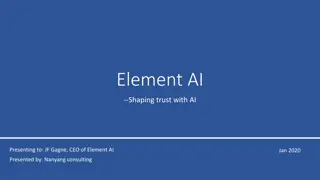
ELEMENT AI
Explore how ELEMENT.AI aims to bring change while overcoming fear that hinders AI adoption. Dive into internal and external analysis, identifying strengths, weaknesses, threats, and opportunities. Discover strategies to address negative public perceptions and lengthy sales cycles through educational initiatives and media partnerships.
Uploaded on | 2 Views
Download Presentation

Please find below an Image/Link to download the presentation.
The content on the website is provided AS IS for your information and personal use only. It may not be sold, licensed, or shared on other websites without obtaining consent from the author. If you encounter any issues during the download, it is possible that the publisher has removed the file from their server.
You are allowed to download the files provided on this website for personal or commercial use, subject to the condition that they are used lawfully. All files are the property of their respective owners.
The content on the website is provided AS IS for your information and personal use only. It may not be sold, licensed, or shared on other websites without obtaining consent from the author.
E N D
Presentation Transcript
ELEMENT AI PRESENTED BY PRESENTED BY PRESENTED TO PRESENTED TO HEC CONSULTING HEC CONSULTING JEAN-FRANCOIS GAGNE ADITYA BAID YOSHUA BENGIO LORETTA CHAN NEHA SHARMA EMILIE L.CAYER
Agenda 1. Problem statement 2. Analysis 3. Recommendations 4. Implementation 5. Conclusion
How can ELEMENT AI bring change when fear impedes adoption? 1. HOW DO WE, AS A COMPANY AND AN INDUSTRY, PROMOTE THE OPPORTUNITI ES CREATED BY AI YET ADDRESS THE PERCEIVED DOWNSIDES? 2. WHAT ARE THE RISKS ASSOCIATED WITH THAT AND WHAT ARE THE RISKS I F WE DON T ADDRESS IT? 3. WHO DO YOU THINK IS OUR TARGET AUDIENCE? 4. WHO ARE OUR NATURAL OR UNNATURAL PARTNERS IN CREATING THIS CHANG E?
Why use AI? Can help perform repetitive jobs in several industries Chatbots, Robotics More connected access to singular person s data Intelligent networks can help improve themselves and perform better analysis / R&D Integration with other technologies can help improve living standards and convenience to help consumers spend time on better things. Eg Smart homes
How do we, as a company and an industry, promote the opportunities created by AI yet address the perceived downsides? QUESTION 1
What does the internal and external analysis says? Strengths Weaknesses Customizable solutions to client Skilled labors Global clients Own their own products and software Backed by multiple companies ($US 250M in 3 rounds) Long sales cycles Threats Opportunities Negative media information AI negative public perception and fear Increasing competition Growing interest in AI from businesses and consumers Increasing knowledge of AI Tech-savvy consumers ELEMENT AI NEEDS TO DEAL WITH THE NEGATIVE PUBLIC PERCEPTION OF AI AND THE LONG SALES CYCLES IT IS CREATING BY TAKING ADVANTAGE OF THE GROWING INTEREST OF AI FROM CUSTOMERS THE BUSINESSES SERVES.
What should the new conversation be for the company? 1. Internship and school visits to educate younger generations about AI 2. Media partnership and CSR to promote the service offering and how it benefits the world
What should the new conversation be for the industry? 1. Switching the discussion from dystopian doomsday scenarios to real world issues due to AI 2. Educating the public on AI as a specialized tool 3. Involving government in the conversation and preparing for an AI future
How to switch the public discussion? 1. Use of news media to reframe questions Instead of focusing on a future which is long away, we need to focus on the very real challenge AI is going to pose to the job market. How would the government prepare for an inevitable AI future?
How to educate the public on AI usage? 1. Educating through internet videos (mass audience) (Youtube, Netflix, Vox) Documentaries debunking AI myths and how it improves lives 2. Using education and business podcasts (younger business clients) More in-depth education for clients aware of technology trends 3. Opinion columns on business journals (business clients) Credibility 4. CBC, TVO and Radio Canada segments for re-education Interviewing university students working on AI
Implementation timeline for educating the public 1Q2020 2Q2020 3Q2020 4Q2020 1Q2021 Podcast Guest for podcasts Create content for own podcast Release of podcasts Documentary Start discussions with media partners for documentary Documentary release on platform (Netflix) Opinion columns CBC, Radio-Canada and other general population media Start discussions for short presentation Release of short documentary on news outlet
How to involve the government? 1. Talk about the disruption in the AI and how the government should prepare for an inevitable AI future? in the news media 2. Balancing the need to have future AI jobs while ensuring re-training of those affected by AI 3. The change of jobs industries and need for lifelong learning for workers and how would universities shift to help lifelong education of the workforce?
What are the risks associated with that and what are the risks if we don t address it? QUESTION 2
What are the risks associated with perceived downsides? 1. People fear losing their jobs to technology 2. Fear of losing control over own data (partly due to lack in cyber laws) 3. Technology can be perceived as intrusive 4. Self-learning algorithms perceive as detrimental 5. Technology still immature and can not perform cognitive functions. 6. Fear of fake news and data Manipulation. Ex Cambridge Analytica
What are the risks of not addressing perceived downsides? 1. Negative perception affect adoption by consumers and businesses 2. Difficulties in closing sales and changing general perceptions by the AI companies 3. Less AI players leads to less innovation in industry and maturity of technology, and creation of monopolies 4. Less maturity in the industry leads to ineffective solutions which can become costly for adopting businesses 5. Many repetitive, routine and unsafe work can be performed by technology 6. Immature technology can not help improve standard of living for the consumers to make their lives better
Who do you think is our target audience? Who are our natural or unnatural partners in creating this change? QUESTION 3 - 4
Who are the stakeholders? INDUSTRY Difficult to get funding to develop the technology High risk of failure Shortage of AI talents ADOPTING COMPANIES (TARGET AUDIENCE) Want to increase their attractiveness with high technology Not willing to bear risks associated with new technology CONSUMERS (TARGET AUDIENCE) Lack AI knowledge Concerns of data security Millennials are more tech-savvy and might be more attracted
Who are the stakeholders unnatural partners? INVESTORS Difficult to find scalable investments High risk of the investment MEDIA Affect public opinion positively and negatively Danger of manipulation of data EDUCATIONAL INSTITUTES Increase in education to students and provide AI experts Provide R&D funding
Conclusion 1. How do we, as a company and an industry, promote the opportunities created by ai yet address the perceived downsides? Spread awareness using communication plan 2. What are the risks associated with that and what are the risks if we don t address it? Lack of knowledge negatively affects adoption and the maturity of the AI industry 3. Who do you think is our target audience? General population (consumers) and adopting companies 4. Who are our natural or unnatural partners in creating this change? Government, media, adopting companies and investors
Thank you! QUESTIONS?






















